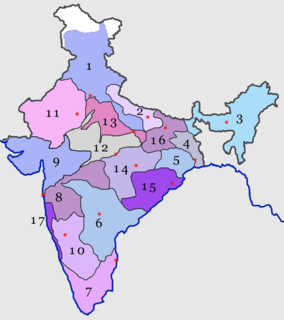
Hisar district is one of the 22 districts of Haryana, India. Hisar city serves as the district headquarters. The district is also part of Hisar division, which is headed by a commissioner who is employed by the Indian Administrative Service.
Haryana is a state in India. The history of Haryana dates back thousands of years. The state houses several sites from the Indus Valley Civilization, which was a cradle of civilization.

The Haryana Police Department is the law enforcement agency for the state of Haryana, India.

The following outline is provided as an overview of and topical guide to Haryana.

The Sahibi river, also called the Sabi River, is an ephemeral, rain-fed river flowing through Rajasthan, Haryana and Delhi states in India. It drains into Yamuna in Delhi, where its channeled course is also called the Najafgarh drain, which also serves as Najafgarh drain bird sanctuary. Sahibi is a seasonal river which is 300 km long and flows from Aravalli hills in Rajasthan to Haryana, of which 100 km is in Haryana.
Forests Department, Haryana is a Ministry and department of the Government of Haryana in India.

Madhogarh Fort is located on top of Madhogarh Hill in the Aravalli mountain range, near Madhogarh village, in the Mahendragarh district of Haryana state in India. It is located 12 kilometres (7.5 mi) from Mahendragarh, reachable via Satnali Chowk and RPS group of Education.
Tourism in Haryana relates to tourism in the state of Haryana, India. There are 21 tourism hubs created by Haryana Tourism, which are located in Ambala, Bhiwani Faridabad, Fatehabad, Gurgaon, Hisar, Jhajjar, Jind, Kaithal, Karnal, Kurukshetra, Panchkula, Sirsa, Sonipat, Panipat, Rewari, Rohtak, Yamunanagar, Palwal and Mahendergarh.

Bisahan is a village in the Beri tehsil of Jhajjar district of Haryana, India. The village lies roughly 5 kilometres (3.1 mi) from the town of Beri.
Western Yamuna Canal from Yamuna, is the Prithviraj Chauhan era or possibly earlier pre-existing canal that was dug out and renovated in 1335 CE by Firoz Shah Tughlaq, excessive silting caused it to stop flowing in 1750 CE, the British raj undertook a three-year renovation in 1817 by Captain GR Blane or Bengal Engineer Group, in 1832-33 Tajewala Barrage dam at Yaumna was built to regulate the flow of water, in 1875-76 Pathrala barrage at Dadupur and Somb river dam downstream of canal were built, in 1889-95 the largest branch of the canal Sirsa branch was constructed, the modern Hathni Kund Barrage was built in 1999 to handle the problem of silting to replace the older Tajewala Barrage.

Tangri river, also called Dangri river, originating in Shivalik Hills, is a tributary of Ghaggar river in of Haryana state of India.

Pathrala Barrage is a barrage across the Somb river, located in Yamuna Nagar District, in the state of Haryana, India.
The Indori river, is a rain-fed river originates from Aravalli Range from Sikar district and flows through Alwar district of Rajasthan to Rewari district of Haryana and it is the longest tributary of Sahibi River which stretches to 50 km. In Delhi, it is called the Najafgarh drain or Najafgarh Nallah.
The Krishnavati river, also called Kasaunti, is a rain-fed river originates from Aravalli Range near Dariba copper mines in Rajsamand district of Rajasthan, and flows through Patan in Dausa district and Mothooka in Alwar district and then disappears in Mahendragarh district in Haryana where it use to be a tributary of Sahibi River, which in turn still is a tributary of Yamuna. Several Ochre Coloured Pottery culture sites have been found along the banks of Krishnavati, Sahibi river, Dohan river and Sota River. The drainage pattern for all these rivers is dendritic.
Civil Aviation Department, Haryana is a Ministry and department of the Government of Haryana in India.

Rail network in the state of Haryana in India, is covered by 5 rail divisions under 3 rail zones, namely, North Western Railway zone, Northern Railway zone and North Central Railway zone.

Haryana State Industrial and Infrastructure Development Corporation (HSIIDC), formerly Haryana State Industrial Development Corporation (HSIDC), headquartered at Panchkula, is a 100% state owned agency of the Government of Haryana in the Indian state of Haryana. For ease of doing business, Haryana is the first state in India to introduce a Labour Policy in 2005 and Land Pooling Policy in 2017, for which HSIIDC acts as the nodal agency. Haryana Financial Corporation provides financial assistance for setting up new industrial units and for the expansion and diversification of the existing industries. Various universities, educational and training institutes, including the nation's first skills university Haryana Vishwakarma Skill University, provide the human resources to capitalise on the infrastructure created by the HSIIDC.

National Highway 152D -cum-expressway from Gangheri to Narnaul is an under construction barrier-free tolled 6-lane National Highway in Haryana state of India. This 230 km long diagonal highway through Haryana state, from Kurukshetra in northeast to Narnaul in southwest, will start from the junction of NH152 near Gangheri and Ismailabad, pass through Kaul Dhatrath, Pundri, Lakhan Majra, Kalanaur, Bhiwani, Charkhi Dadri and terminate at junction with NH148B at Narnaul bypass. Its straight-line greenfield alignment will reduce the distance from the state capital Chandigarh to Narnaul and Jaipur while decongesting NH1 and NH44. The alignment intersects with at least 15 NH including NH9 and several State Highways (SH) including SH6, SH9, SH8, SH11, SH12, SH14, SH10, SH16A, SH20, SH24 and SH26. Area around it is being developed as an industrial corridor.
























